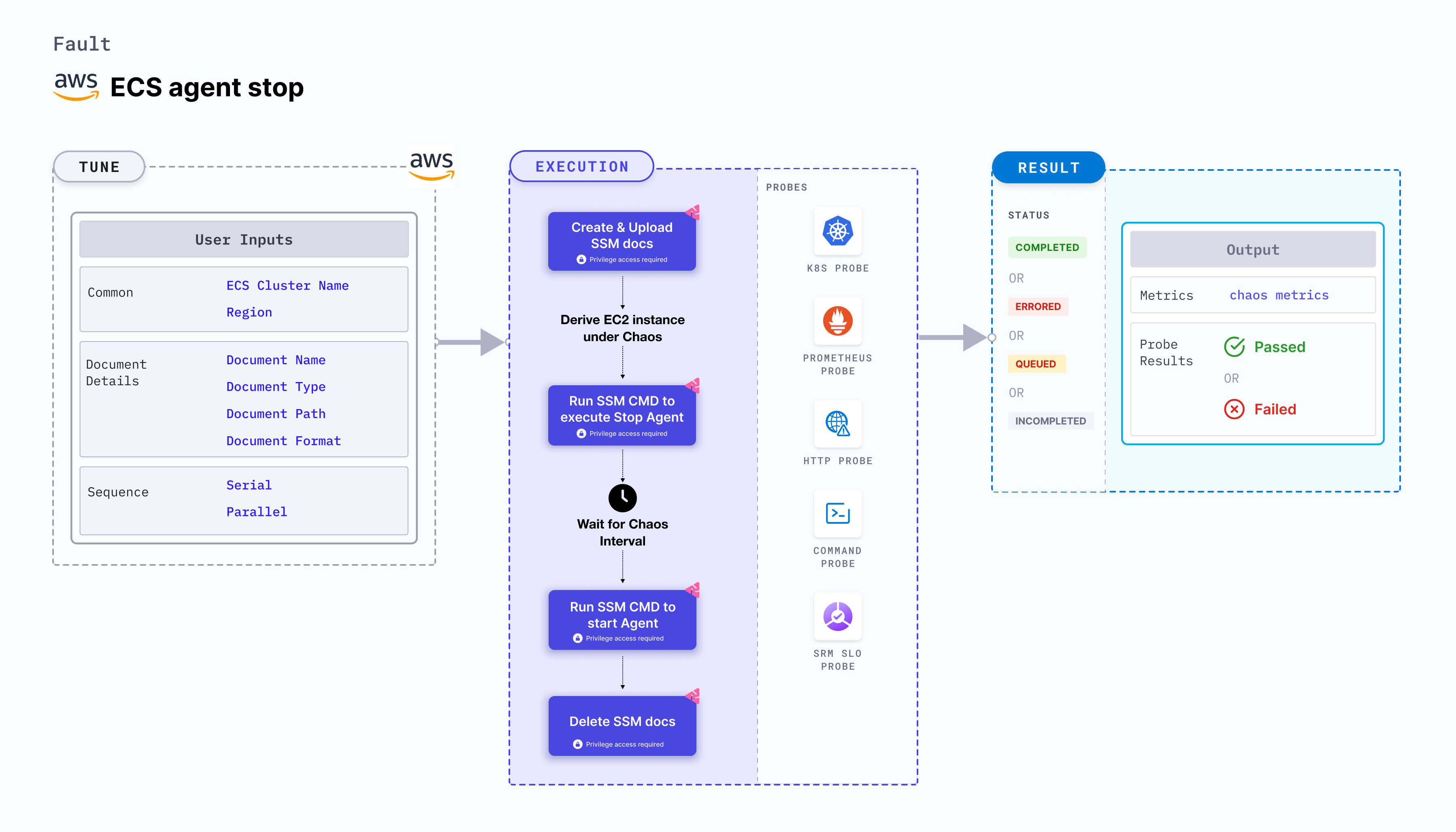ECS agent stop
ECS agent stop disrupts the state of infrastructure resources. This fault:
- Induces an agent stop chaos on AWS ECS using Amazon SSM Run command, that is carried out by using SSM documentation which is in-built in the fault for the give chaos scenario.
- Causes agent container stop on ECS for a specific duration, with a given
CLUSTER_NAMEenvironment variable using SSM documentation. Killing the agent container disrupts the performance of the task containers.

Use cases
ECS agent stop halts the agent that manages the task container on the ECS cluster, thereby impacting its delivery.
Prerequisites
- Kubernetes >= 1.17
- The ECS container instance should be in healthy state.
- ECS container metadata should be enabled (this feature is disabled by default). To enable it please follow the aws docs to Enabling container metadata. If you have your task running prior this activity you may need to restart it to get the metadata directory as mentioned in the docs.
- You and ECS cluster instances have a role with the required AWS access to do SSM and ECS operations. Go to Systems Manager documentation.
- The Kubernetes secret should have the AWS access configuration(key) in the
CHAOS_NAMESPACE. A sample secret file looks like:apiVersion: v1
kind: Secret
metadata:
name: cloud-secret
type: Opaque
stringData:
cloud_config.yml: |-
# Add the cloud AWS credentials respectively
[default]
aws_access_key_id = XXXXXXXXXXXXXXXXXXX
aws_secret_access_key = XXXXXXXXXXXXXXX
tip
HCE recommends that you use the same secret name, that is, cloud-secret. Otherwise, you will need to update the AWS_SHARED_CREDENTIALS_FILE environment variable in the fault template with the new secret name and you won't be able to use the default health check probes.
Below is an example AWS policy to execute the fault.
{
"Version": "2012-10-17",
"Statement": [
{
"Sid": "VisualEditor0",
"Effect": "Allow",
"Action": [
"ecs:UpdateContainerInstancesState",
"ecs:RegisterContainerInstance",
"ecs:ListContainerInstances",
"ecs:DeregisterContainerInstance",
"ecs:DescribeContainerInstances",
"ecs:ListTasks",
"ecs:DescribeClusters"
],
"Resource": "*"
},
{
"Effect": "Allow",
"Action": [
"ssm:GetDocument",
"ssm:DescribeDocument",
"ssm:GetParameter",
"ssm:GetParameters",
"ssm:SendCommand",
"ssm:CancelCommand",
"ssm:CreateDocument",
"ssm:DeleteDocument",
"ssm:GetCommandInvocation",
"ssm:UpdateInstanceInformation",
"ssm:DescribeInstanceInformation"
],
"Resource": "*"
},
{
"Effect": "Allow",
"Action": [
"ec2messages:AcknowledgeMessage",
"ec2messages:DeleteMessage",
"ec2messages:FailMessage",
"ec2messages:GetEndpoint",
"ec2messages:GetMessages",
"ec2messages:SendReply"
],
"Resource": "*"
},
{
"Effect": "Allow",
"Action": [
"ec2:DescribeInstances"
],
"Resource": [
"*"
]
}
]
}
note
- This experiment induces chaos within a container and depends on an EC2 instance. Typically, these are prefixed with "ECS container" and involve direct interaction with the EC2 instances hosting the ECS containers.
- Go to AWS named profile for chaos to use a different profile for AWS faults and the superset permission/policy to execute all AWS faults.
- Go the common tunables and AWS-specific tunables to tune the common tunables for all faults and AWS-specific tunables.
Mandatory tunables
| Tunable | Description | Notes |
|---|---|---|
| CLUSTER_NAME | Name of the target ECS cluster | Single name supported For example, demo-cluster. For more information, go to cluster name. |
| REGION | The AWS region name of the target ECS cluster | For example, us-east-2 |
Optional tunables
| Tunable | Description | Notes |
|---|---|---|
| TOTAL_CHAOS_DURATION | The total time duration for chaos insertion (sec) | Default: 30 s. For more information, go to duration of the chaos. |
| CHAOS_INTERVAL | The interval (in sec) between successive instance termination. | Default: 30 s. For more information, go to chaos interval. |
| AWS_SHARED_CREDENTIALS_FILE | Provide the path for aws secret credentials | Default: /tmp/cloud_config.yml |
| SEQUENCE | It defines sequence of chaos execution for multiple instance | Default: parallel. Supports serial and parallel. For more information, go to sequence of chaos execution. |
| RAMP_TIME | Period to wait before and after injection of chaos in sec | For example, 30 s. For more information, go to ramp time. |
Agent stop
Target agent that is stopped for a specific duration. Tune it by using the CLUSTER_NAME environment variable.
The following YAML snippet illustrates the use of this environment variable:
# stops the agent of an ECS cluster
apiVersion: litmuschaos.io/v1alpha1
kind: ChaosEngine
metadata:
name: engine-nginx
spec:
engineState: "active"
annotationCheck: "false"
chaosServiceAccount: litmus-admin
experiments:
- name: ecs-agent-stop
spec:
components:
env:
# provide the name of ECS cluster
- name: CLUSTER_NAME
value: 'demo'
- name: REGION
value: 'us-east-2'
- name: TOTAL_CHAOS_DURATION
VALUE: '60'